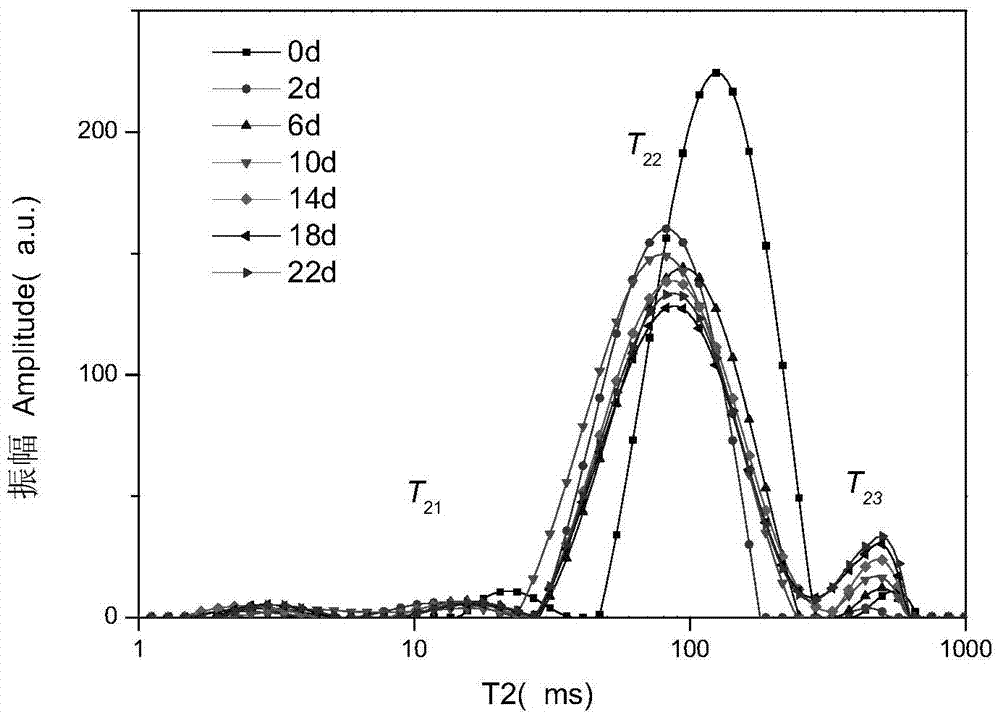Method for detecting texture quality by low field nuclear magnetic resonance in sea cucumber salting process
A low-field nuclear magnetic resonance and detection method technology, which is applied in the detection field, can solve the problems of quality identification of unseen sea cucumber salting, etc., and achieve the effects of rapid measurement, accurate measurement results and good reproducibility
- Summary
- Abstract
- Description
- Claims
- Application Information
AI Technical Summary
Problems solved by technology
Method used
Image
Examples
Embodiment 1
[0034] Take fresh sea cucumbers, remove the internal organs and the five longitudinal ribs attached to the inner wall, rinse the inner wall repeatedly with clean water, and rinse with double distilled water 3 times. Pre-cooked at 70°C for 30 minutes, cooled naturally, placed in 15% brine, and salted at 4°C for 2, 6, 10, 14, 18, 22 days.
[0035] The MiniMR-Rat nuclear magnetic resonance imaging analyzer was used to detect the salted sea cucumber samples. The parameters were set as follows: 90 degree pulse width P1: 13 μs, 180 degree pulse width P2: 26 μs, repeated sampling waiting time Tw: 5000 ms, analog gain RG1: 15. Digital gain DRG1:3, preamplification gain PRG:1, NS:8, NECH: 3000, receiver bandwidth SW: 200KHz, start sampling time control parameter RFD: 0.002ms, time delay DL1: 0.1ms. Then use the one-dimensional inverse Laplace algorithm as the transverse relaxation time T2 inversion algorithm (number of iterations: 1000000) to obtain the transverse relaxation characteristi...
Embodiment 2
[0041] Take fresh sea cucumbers, remove the internal organs and the five longitudinal ribs attached to the inner wall, rinse the inner wall repeatedly with clean water, and rinse with double distilled water 3 times. Pre-cooked at 70°C for 30min, cooled naturally, placed in saturated brine, and salted at 4°C for 2, 6, 10, 14, 18, 22 days.
[0042] Using MiniMR-Rat magnetic resonance imaging analyzer to detect sea cucumber samples, the parameters are set to: 90 degree pulse width P1: 13 μs, 180 degree pulse width P2: 26 μs, re-sampling waiting time Tw: 5000 ms, analog gain RG1: 15, Digital gain DRG1:3, preamplification gain PRG:1, NS:8, NECH: 3000, receiver bandwidth SW: 200KHz, start sampling time control parameter RFD: 0.002ms, time delay DL1: 0.1ms. Then use the one-dimensional inverse Laplace algorithm as the transverse relaxation time T2 inversion algorithm (number of iterations: 1000000) to obtain the transverse relaxation characteristic map of each sample (such as image 3 ,...
Embodiment 3
[0049] Take fresh sea cucumbers, remove the internal organs and the five longitudinal ribs attached to the inner wall, rinse the inner wall repeatedly with clean water, and rinse with double distilled water 3 times. Pre-cook at 70°C for 30min, cool naturally, place in dry salt, and salt for 2, 6, 10, 14, 18, 22 days at 4°C.
[0050] The MiniMR-Rat nuclear magnetic resonance imaging analyzer was used to detect the sea cucumber samples. The parameters were set to: 90 degree pulse width P1: 13 μs, 180 degree pulse width P2: 26 μs, re-sampling waiting time Tw: 5000 ms, analog gain RG1: 15, Digital gain DRG1:3, preamplification gain PRG:1, NS:8, NECH: 3000, receiver bandwidth SW: 200KHz, start sampling time control parameter RFD: 0.002ms, time delay DL1: 0.1ms. Then use the one-dimensional inverse Laplace algorithm as the transverse relaxation time T2 inversion algorithm (number of iterations: 1000000) to obtain the transverse relaxation characteristic map of each sample (such as Fig...
PUM
 Login to View More
Login to View More Abstract
Description
Claims
Application Information
 Login to View More
Login to View More - Generate Ideas
- Intellectual Property
- Life Sciences
- Materials
- Tech Scout
- Unparalleled Data Quality
- Higher Quality Content
- 60% Fewer Hallucinations
Browse by: Latest US Patents, China's latest patents, Technical Efficacy Thesaurus, Application Domain, Technology Topic, Popular Technical Reports.
© 2025 PatSnap. All rights reserved.Legal|Privacy policy|Modern Slavery Act Transparency Statement|Sitemap|About US| Contact US: help@patsnap.com



